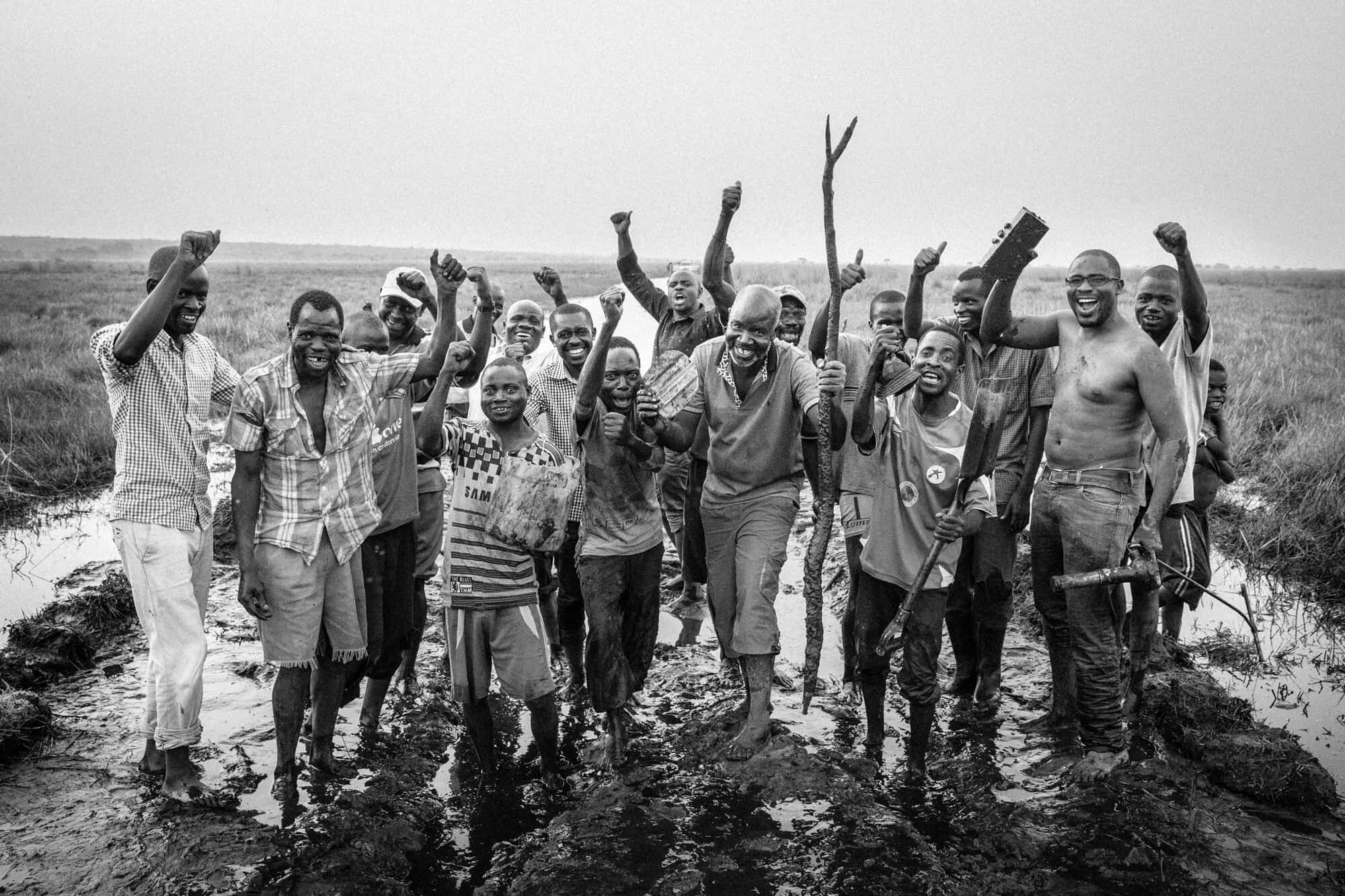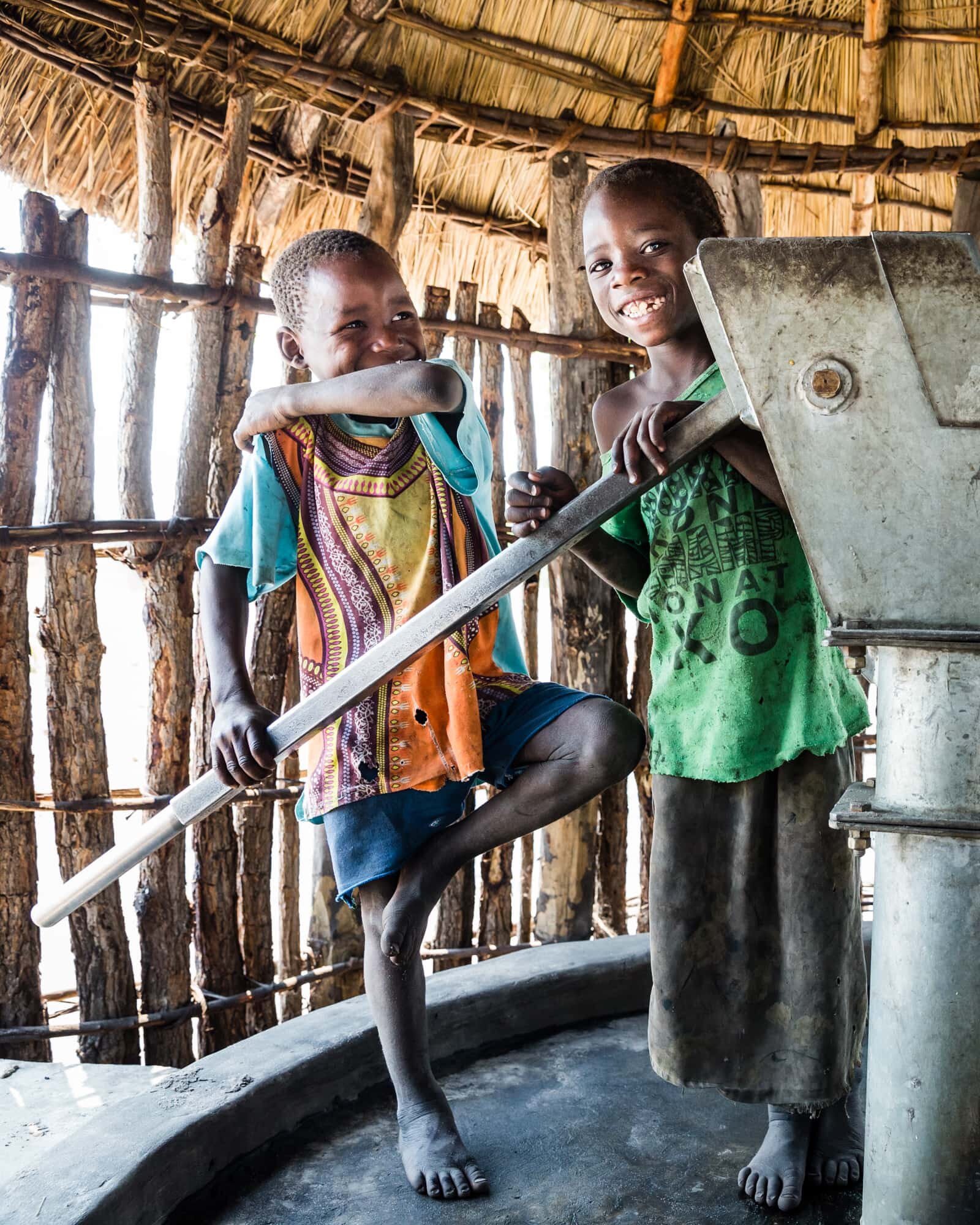
Local heroes
Fighting blinding trachoma
Client: Sightsavers/Uniting to Combat Neglected Tropical Diseases
Farmers celebrate after a five hour battle to extract a vehicle stuck in the cloying mud of the Zambezi flood plain. The vehicle belonged Bruno Kandei, an eye surgeon who travels the plain with his mobile eye clinic treating patients suffering with blinding trachoma.
Navigating the confusion of tracks in this remote area of Zambia is treacherous even for the locals and Bruno regularly gets stuck. But when the call for help goes out, local farmers always respond, many walking from miles around to assist.
All photos for Sightsavers/Uniting to combat Neglected Tropical Diseases
What is Blinding Trachoma?
Trachoma is a disease caused by a contagious bacterial infection of the eye. It is commonly spread through contact with contaminated hands or clothing and by flies coming into contact with a person’s eyes or nose.
Blinding trachoma often begins in early childhood and progresses over the years due to episodes of reinfection, causing inflammation and scarring of the inner eyelid. In some people, repeated infection damages the eyelids, causing the eyelashes to turn inwards and to painfully rub against the eye’s surface (a condition known as trichiasis).
If left untreated, a series of complications can lead to irreversible blindness. Trachoma is directly linked to poverty; communities without access to clean water or effective sanitation are the most vulnerable. The disease has a devastating impact on livelihoods because it limits access to education and prevents individuals from being able to work or care for themselves or their families.
167 million people live in areas endemic for blinding trachoma and it is a public health problem in Asia, the Americas, Australia and the Middle East. 90% of those affected live in Africa.

Kalabo District in Western Zambia where eye surgeon Bruno Kandei operates. The area is a vast flood plain for the Zambezi River, much of which is waterlogged for six months of the year.
Very few NGOs choose to operate in the area - and with good reason. The flood plain is inaccessible for half of the year, for the the other half the barely navigable roads are a mix of deep sand and cloying mud. These conditions result in high fuel and maintenance costs, testing even the most capable 4x4 vehicles.
Despite the daily challenges, medical teams can always rely on the unwavering support of local communities who are prepared to get their hands dirty to keep operations moving. Above and below, Robert Ntitima, an eye care development specialist, works with local farmers to free Bruno’s vehicle from the mud.
After the vehicle is freed – which required a dam to be built and the water drained – everybody gathers for a celebratory picture, Bruno standing in the middle holding the stick

Locals continue their own journey as dusk falls. It was the young shepherd boys who first raised the alarm, running to seek assistance from farmers in the area.

On slightly higher ground, a trachoma assessment clinic is set up under a trail of mango trees – the trees representing the community spirit found across much of Africa. Planted nearly 100 years ago by migrant workers travelling to the mines in South Africa, the mango trail extends for over 400km. The idea was that the trees would provided food for the migrants’ return journey and for future generations following in their footsteps.
The assessment clinic is a relaxed affair, where people from the surrounding villages gather to share stories and tell jokes as they wait patiently to be assessed. The medical team are well known in the area and trusted by the communities they serve.
Matakala Inonge, 76, is assessed for blinding trachoma by eye surgeon Bruno Kandei. She is one of the patients who will need an operation to save her sight.

Those requiring treatment had to be transported to the nearest rural medical facility for the operation, but one of the vehicles got stuck in fine sand. After a transfer of patients to another vehicle, Robert Ntitima, right, and his driver Clinton Bakala were left to dig out their vehicle. On our return journey later that night, we found Robert and Clinton exhausted having also beaten back a bush fire to save their stranded vehicle.
The long journey to the medical facility meant Bruno arrived late in the afternoon. He prepares his equipment in the most basic of treatment rooms, leaving the door open so he has enough light to do his work.
In the little time available before the light fails, five patients undergo trichiasis surgery to undo the effects of blinding trachoma.

Community health work volunteer Precious Mukelabai in her kitchen.
Eliminating blinding trachoma requires more than a determined field surgeon, and relies on the local community to play their part too. Precious gives practical advice to the sick, acts as a relationship counsellor and, as one of the few people in the village with a mobile phone, acts as a bridge between the community and the health authorities.
Each family in the village pays about the 10 US cents a month to help maintain their local water pump, an essential resource for life and in the fight against blinding trachoma and other diseases. The villagers have also built a structure around the pump to stop animals soiling the immediate area and to protect the pump from the elements.

Older children lead the young to a village gathering where they'll learn about the importance of washing hands and general hygiene.
Community health worker, Miyombo Zhyinga, stresses the importance of using pit latrines rather than going to the toilet on open ground. “Faeces is a friend to flies!”, she shouts; “and flies are friends with disease!”.
Matakale Inonge, 76, and her friend Sibeso Simate, 72, relax the day after they received treatment to reverse the painful effects of blinding trachoma. It is hoped their generation will be the last to be seriously threatened by this ancient and debilitating disease, responsible for blinding millions of people in the past.
Acknowledgments
The assignment team would like express their gratitude to the rural communities of Kalabo District in Western Zambia along the Zambezi flood plains - for their traditionally warm welcome and for their efforts in keeping our vehicles moving.
We are also very grateful to the following people and organisations for their assistance with this project. They include: Thoko Pooley, Hugh Mehta, Mark Doyle; Sightsavers UK, Sightsavers Zambia, Lions Aid Norway - Zambia, Western Province Health Office in Zambia and Uniting to Combat NTDs.
Special thanks to my good friend Robert Ntitima – Programmes Officer at Lions Aid Norway – for guiding and introducing us to his people. Robert continues to serve the wider community through his ongoing work in Eye Care and NTD programming.
Local hero
Eye surgeon Bruno Kandei specialises in restoring sight by operating on painful ingrowing eyelashes – a symptom of blinding trachoma. ‘Bruno’ is a nickname his school friends gave him in the 1960’s and it stuck. But his real first name is ‘Kubona’, which in his local language means ‘the ability to see’.
Eye surgeon Bruno Kandei









